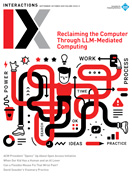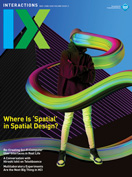Authors:
David A. Shamma
What are you working on right now?
I've been an industry research scientist and research science manager since graduating with my Ph.D. from Northwestern University. I spent 10 years at Yahoo doing research at the intersection of CS, AI, and HCI. For half my time there, I was chief scientist at Flickr, the photo-sharing site. Afterward, I took a break from Silicon Valley to research the next generation of ubiquitous wearables. Working with Centrum Wiskunde & Informatica in the Netherlands, I collaborated with designer Byborre to bring sensor-based activity tracing using ubiquitous technologies to life in dance clubs. We looked at how people engage with exciting physical spaces and how tracking and tracing (with consent) could help us as technologists understand more about how to elevate experiences (https://bit.ly/4kohy5G). More recently, I've focused on conference room collaboration tools (at FX Palo Alto Laboratory) and carbon neutrality (at Toyota Research Institute). I've been examining how we think about CO2 emissions and how people can make more eco-friendly decisions (https://bit.ly/4mgM0jN; https://bit.ly/4jTALvZ).
What inspired you to forge a career in HCI?
I started my research career in AI back when "AI" was a different thing. Deep neural nets weren't around; knowledge representation, intelligent systems, and vector machines were at the forefront. What attracted me to AI was how people interact with it. At its core, this is human-centered AI, which we called human-centered computing back in the day. It wasn't until after my Ph.D. that I thought about submitting something to SIGCHI. I proposed and ran a workshop on creative processes at Creativity and Cognition in 2007. I found myself surrounded by like-minded people trying to understand how people interact with technology; it felt like home. Fast-forward and the field is still about humans and how we interact with AI, and complex multimedia, multimodal interactive systems.
I'm looking forward to seeing how the things we do in research turn into everyday interactions.
Which volunteering roles are you taking on right now?
I've done a lot of volunteering, starting in SIGMM and then in SIGCHI. In late 2019, I joined the CHI Steering Committee when I took the role of the technical program chair for CHI 2022. It was right before the Covid pandemic. What was supposed to be running a routine conference program ended up as planning the first (and only) truly synchronous hybrid CHI. I've written with colleagues about the complicated balance of pixels streaming with structured blended interactions (https://bit.ly/4mgM0jN).
Currently, I'm on the CHI Steering Committee and serving as a general cochair of CHI 2026.
What drew you to take on this role?
Have you ever submitted to a conference and felt upset about the process? Ever thought about how a conference could be run better or how the review process could be more inclusive? We get to hear about pros and cons at conference town halls, but to actually get in there and change the processes takes work and time. That is what motivates me. I'd like to think my technical training, multimedia research, and industry experience helped me to contribute to making that first hybrid CHI in 2022 successful.
What are you working on right now?
CHI 2026 is changing its format to scale up with the community. Most AI conferences, emulating medical research conferences, have become large-scale poster sessions. Crowded poster sessions with little engagement are not right for SIGCHI members. Subsequently, we're reconfiguring the CHI conference, including tracks, the ways in which the doctoral mentoring program is run, and more. We want to have a broader, more diverse program. CHI 2026 will be in Barcelona, which provides us with connections to communities in the Iberian Peninsula, across the Mediterranean, and into Africa.
What is one thing you'd like to see happening in the SIGCHI community?
It would be great if everyone would pick one paper they were going to send to CHI and send it somewhere else. There are more than 20 specialized conferences under SIGCHI. Think about sending it to one of those alternative venues. SIGCHI is broader than CHI, and smaller venues may offer more contact with like-minded people. As 2026 general cochair I am pro-CHI obviously, but I also want to promote other HCI venues that may be better for furthering research careers.
Ten years from now, what issues do you imagine the HCI community may be confronting?
We're seeing HCI ideas and philosophies affect AI. Universities have centers for HCAI, HCI AI. Companies have divisions for HCAI. In 10 years, when the field enters adolescence, AI responsibility, AI for behavior change, and AI for sustainability will be major areas of inquiry.
What excites you about the future of our field?
I'm looking forward to seeing how the things we do in research turn into everyday interactions. We've seen research from academia grow into real-life exercise trackers. Grammar and editing tools have become common with large language models. Seeing the research ideas we have now grow is what excites me about the future.
What advice would you give a young colleague at the start of their professional career?
In 2023, I gave a talk on human-centered AI systems at Deep Learning Indaba in Ghana. In the days before my talk, I attended a few poster sessions that were incredible. There were so many amazing applications of AI for African-centered questions—from monitoring irrigation patterns to predicting if palm oil, the ubiquitous staple in cooking, had gone bad. After my talk I was asked this same question. I said: Do not lose sight of your own questions. It's easy to get caught up in the hot topic at the conference, and it's okay to entertain that. But keep answering the questions you feel are valuable to you, your research, and your community. That's how you'll make your voice heard.
What is one thing you've gotten wrong about tech?
I never thought I'd see a self-driving car in my lifetime. Now I take them regularly in San Francisco. It's just a boring ride-share.
Is there a vision of the future that you had as a child that still persists?
Are we at the point where I talk about robots and how they were supposed to be our friends? I'll stick with my human friends, knowing that I just said the robots are driving the ride-shares.
Would you like to share any concluding thoughts?
We've been talking about a people-first approach to research, but this point goes deeper. I aim to have this people-first mindset in all my collaborations. As we prepare for CHI 2026, I know it's the people that make it happen. We're very excited, and we may fundamentally improve the conference for years to come. If you haven't volunteered—from reviewing to helping run a conference—do it! You're welcome aboard to help us shape the field.
David A. Shamma is a distinguished industry scientist researching people, AI, and media experiences. His latest research focused on carbon neutrality at Toyota Research Institute's Human-Centered AI division. [email protected]
Copyright 2025 held by owner/author
The Digital Library is published by the Association for Computing Machinery. Copyright © 2025 ACM, Inc.








Post Comment
No Comments Found